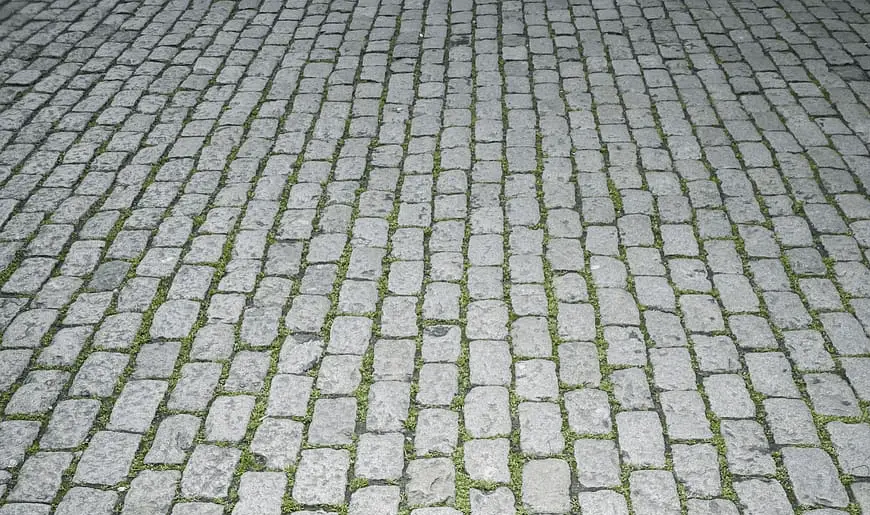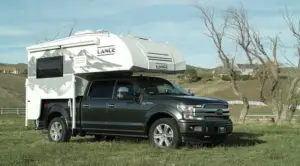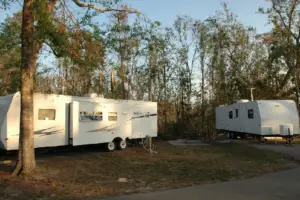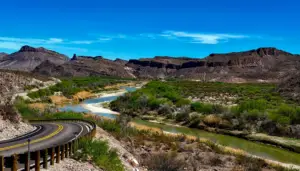Have you been wondering about RV parking pad ideas to store your RV at home? No wonder you are here, keep reading to find out the best surfaces you can park your RV on.
Storing a RV at a commercial storage can cost you few thousand dollars a year. This can vary depending on weather you need indoor storage and the heating option. Even with minimum facilities this isn’t a low cost option.
Storing RV at home also means risking its well being if not stored properly. A parking pad need to be good enough to keep the RV from all the damages the water can cause.
The ground need to be strong enough to handle its weight. It should also be able to facilitate easy access of camper should you want to move it any time.
RV tires need special attention and therefore there are methods that need you to remove the tires itself. But, that can be cumbersome. So, here i present the list of all the options for building a good parking pad that does not need removing tires and also provides for easy RV access.
Here are the parking pad ideas you can use,
Permeable Pavers
Permeable pavers can be considered to be a DIY project which can be undertaken by any individual.
The open cells in the permeable pavers is filled with grass that helps water to enter into their surfaces which is then drained in the base. This leads to absorbing the water in the ground. Hard surfaces may lead to collecting water leading to water pooling.
Permeable pavers are porous resulting in better water draining. The drainage of the water depends on the material used in making the paving system.
These type of systems are quite resilient and strong, similar to the traditional paving materials like compacted gravel, concrete, and asphalt.
At present, you will come across different kinds of porous paving grids which consist of permeable concrete plus asphalt pavements, interlocking concrete grids, rigid or rolled plastic pavers, and plastic grid pavers having fixable joints.
Permeable pavers are appropriate solutions for minimizing flooding risks, safeguarding natural waterways, and also regulating storm water.
For this reason, it is possible to use them for constructing environmentally friendly parking lots, driveways, roadways, as well as industrial yards which are responsible for absorbing and detaining water, thus helping to prevent flooding in the long run.
This system is going to stay close to the ground and will not develop any cracks or potholes while shifting.
In fact, rolled plastic grid will provide optimum soil or gravel retention with optimal permeability. Apart from this, it is possible to roll the paving system which ensures effortless storage and shipping.
Lets see the different types of pavers that can be used. Each of these have their pros and cons in terms of how fast they can drain the water and how long they last. You need to select the material based on RV weight, budget and other factors.
Plastic Grid Pavers : These are best suited as they offer better permeability and also supports good load.
Concrete Permeable Paver : This has very less water draining and also requires more maintenance.
Bricks Permeable Paver : The concrete used in bricks may not be permeable but the gaps in between are. This method may work in less rain areas. Before choosing this system be sure to check other options for your RV parking.
Asphalt Paver : Naturally asphalt is not porous but it can be made to be porous. Using this may not be better idea in case of heavy rain areas as the draining will not be that great.
Rigid Plastic Paver : These are hexagonal cells that are rigid and support better weight but its difficult to install. A DIY project could be a hard one to execute if you aren’t well versed with this.
Rolled plastic Pavers : This may not be good for heavier campers or motorhomes as they can handle only light weight. Therefore be careful if yo choose this one. This can be rolled and stored when not in use.
To summaries lets see the pros of using permeable or grass pavers,
- Reduces flood risk and runoff
- This is a more environment friendly approach for building a parking pad
- The heat and temperature raise due to hard surface is mitigated by this approach.
- Saves space as you wont need a separate water draining by the side of the parking pad.
Vapor Barrier on Grass
In case you park the RV on grass, it is possible for insects and other creepy-crawlers to climb into the RV and build nests. Moreover, the tires can get damaged due to the moisture from the grass.
Fortunately, you’ll come across several options which will help you to prevent these from happening. Leveling blocks, variable barriers, as well as tire covers, will help you to safeguard your investment.
It is natural for grass as well as dirt to retain water, and therefore, exposing the tires of your RV to moisture for a long period of time might decrease the longevity of the tires eventually.
However, in case you are parking your RV in the grass, make it a point to include a vapor barrier in between the tires and the ground.
Another option will be to use leveling blocks as well. You can easily place wood or any other leveling block beneath the tires of the RV so that its weight can be dispersed on the grass effectively.
It is possible to purchase both leveling blocks as well as vapor barriers online.
It will also be possible to safeguard the tires from exposure to sun and moisture by making use of tire covers. In case these are not available to you, a tarp can be wrapped around the tire while keeping it in position utilizing a bungee cord. Make sure the parking pad size is enough to occupy the RV or travel trailer fully.
Lets see the next RV parking pad design that uses gravel.
Gravel
Putting down a plot of gravel or crushed rock will be one more inexpensive method of creating an RV parking pad. Both these materials are quite tire-friendly given that they enable the water to drain as well as dissipate. Nevertheless, it can be a difficult job to figure out the gravel pad’s thickness.
This will depend on the soil conditions where you’re going to park the RV. The gravel can be simply put down in some soil types, and it is going to last for quite some time in the future.
It is possible to build a gravel pad on your own or you can also take the help of an expert.
In case you’d like to construct your personal gravel pad, it will be imperative to dig and get rid of at least 6 to 8 inches of soil. You have to install large base stones at the bottom up to a depth of 4 to 6 inches for making it strong.
Complete the pad with choker angular gravel or regular-sized gravel after making the area compact. You may also talk to other individuals who already have gravel driveways for getting their advice.
Being more inexpensive as compared to concrete, gravel will allow superior water drainage as well as runoff. However, in case you would like to construct a gravel parking pad for your RV, make it a point to place a vapor barrier in between the tires and the ground.
Concrete Pad
So many times i have heard that concrete is not a good parking pad for RV. For the same reason i was skeptical about including it here. But, i think there are fair number for votes for this option as people are happy parking their RVs on concrete made parking pads.
Its obvious that, there wont be any draining here and therefore it needs separate water draining or run off management. The overall construction cost is high. For a typical 16 by 40 foot parking pad the cost is more than $3500.
Other advantages with concrete pad is, it can be cleaned very easily with pressure wash. You can easily move the RV over it and it will be there permanently. Its life will depend on the construction and the quality of the material sued.
So, how thick this parking pad need to be? A 4 inches concrete pad is enough to support the weight of an average RV.
Choose this type of pad if you are sure the RV will be parked there for many years and also the cost is not a factor for you.
Many RVers are confused between gravel vs concrete pad. Gravel is cheaper and drains water faster but RV movement can be hard.
Grass Protection Mesh
This parking pad is made up of synthetic material that is made as a mesh grid. It can be rolled directly over natural grass. Its designed to support RV weight and at the same time preserving the grass underneath.
This method however may not be great if you are worried about the grass. This is a less costly method but may need your additional attention to preserve the grass. Also if you own a very heavy RV then be sure to check with the professional on weight limits for this type of parking mat.
So, after going through so many options, confused on whats the best material for your RV parking pad? Don’t be. Lay out your requirements, budget and that should give you the best option.
Tips For Parking RV At Home
In case space is available to you, it will be sensible to park the RV on your property.
This might imply making use of an empty place in the driveway, converting the side yard into a parking area, widening the driveway for including a parking spot for the RV or even coming across an area on your property where the RV can be stored for the long-term.
Below, I have mentioned some vital guidelines for parking your RV at home.
Be Careful Regarding The Neighbors
It is less likely for your neighbors to complain in case the RV isn’t obstructing their views by any means. Therefore, make sure that your recreational vehicle is not towering on top of the outdoor living areas of your neighbors.
Moreover, make it a point not to block the line of sight of your community members. It is imperative for them to be able to see around the RV whether any bicycle, car or pedestrian is approaching down the street.
The Sidewalk Should Not Be Blocked
In case your RV is parked in front of your residence, ensure to have lots of space for parking it and it should not block the sidewalk whatsoever.
This is going to be a violation and you will be hearing lots of complaints from your neighbors in case the sidewalk is blocked.
Build A Solid Foundation
It is possible for the parking spot of your RV to be a concrete slab, gravel, or an attractive paving stone driveway.
In case the new parking spot is matching the existing driveway of yours, it might be sensible to install a wider paving stone driveway out there.
Trim Bushes And Trees
It might be imperative to trim any nearby shrubs, trees, or bushes so that you have adequate clearance for your RV.
Take Your Roofline Into Consideration
In case the RV parking space is created in your side yard or close to your residence, be mindful of the roofline and ensure that you have adequate space.
Be Mindful Of The Slope
It might be the fact that the area where your RV is parked happens to be a slope, and in that case, you have to block the wheels effectively.
Moreover, in case the RV comes with a refrigerator, parking on a slope for a long time might also cause problems. Try to keep your RV on a level area as far as possible and also switch off the refrigerator once it is parked.
Go For An RV Garage Or Covered Parking
Although constructing a carport or a garage for the RV might prove to be a costly option and is going to need permits, you as well as your neighbors might prefer this alternative provided it fits your budget.
Read : How much does Covered RV storage costs?
Figure Out The Way To Provide Electricity
There will be no need for you to have any access to electricity in case your RV is simply parked or you are planning to use it for backyard camping or as a guesthouse.
In case you’d like to have electricity for the RV, there are 2 options in front of you. Firstly, you might connect the RV to the electrical system of your residence using an electric cable.
Otherwise, you might take the help of an electrician for setting up an electrical hookup. The first option will provide adequate amps to the RV for operating small appliances as well as lights; however, an electrical hookup for the RV will be required in case you’d like to operate an air conditioner.
Figure Out How To Take Care Of The Waste
While you are traveling on the road, you can make use of the tank of the RV and also empty it as and when required. Otherwise, the tank can also be hooked up with the septic system of your residence.
However, this option will not be worth the cost in case you do not want to use your trailer as long-term.
Nevertheless, you can make use of the water derived from the gray water tank for irrigating ornamental landscaping and the black water tank can likewise be emptied if required.
Determine How Water Should Be Provided
In case you’d like to make use of the RV as a guesthouse for the long-term, you can consider hiring a plumber for installing a water hookup at the parking spot of the RV.
Otherwise, it can simply be hooked up to the waterline of your residence as well. In case you’d like to opt for the second option, make sure to employ a white hose which has been designed particularly for potable water.
The usage of a conventional garden hose is not recommended in this case.
Conclusion
Each of the ideas we discussed above can be implemented as a DIY project. However, in case you do not have adequate time as well as cash, it will be prudent to take the help of an expert who can accomplish the job faster.
It does not matter whether you perform the task yourself or with the help of a professional, make it a point that the RV pad covers the tire’s entire area so as to prevent any unwanted damage in the long run.





